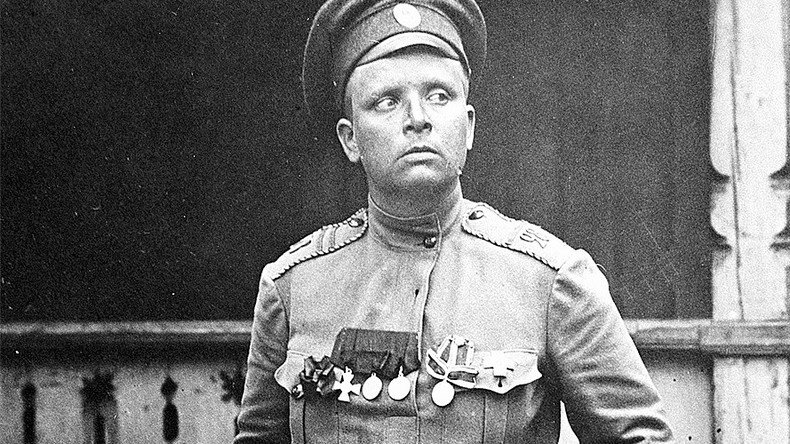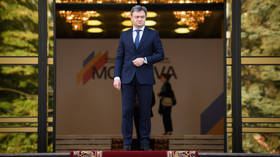#1917CROWD: Russian soldier Maria's war against Germany & sexism

A century ago, a Russian female battalion led by Maria Bochkareva set off to the WWI front, where at least 70 women lost their lives fighting against German troops. RT looks back at the incredible phenomenon that was the soldier Bochkareva.
She was born into a peasant family in Imperial Russia in 1889, which was a verdict to a life of hard labor without any rights – such were the harsh realities of peasant women in those days.
Indeed, Maria’s life started off miserably. She was sent to work at the age of eight, received regular beatings, was a victim of sexual assault, and was harshly beaten by all the men in her life, including her father and husband.
What made Bochkareva stand out though was that she refused to accept a lifestyle considered normal for women of her class back then.
When the war with Germany and Austria-Hungary broke out in 1914, she firmly decided to leave her past behind and become a soldier.
There can be no peace in Mother Russia while German soldiers are on our land. I want to drive them OUT #1917LIVEpic.twitter.com/i4SrcfePlC
— Maria Bochkareva (@bochkareva1917) July 3, 2017
“I cut off my hair, dressed in men’s clothes, and provided myself with two loaves of bread,” Bochkareva recalls in her memoirs, written down by bilingual American journalist Isaac Don Levine in 1918.
Not surprisingly, she was denied entry into the Imperial Army because she was a woman and was advised to try herself out as a sister of mercy.
Was advised to go as a nurse in the rear. Enough of sexual harassment and rape in my life. I wanted to be a soldier in the front #1917CROWD
— Maria Bochkareva (@bochkareva1917) June 13, 2017
Desperate, Maria sent a direct telegram to Tsar Nicholas II, and to everyone’s astonishment, she received a positive answer. This direct message from the emperor would serve here more than once in her adventures.
In November 1914, she joined the 25th Tomsk Reserve Battalion of the Imperial Russian Army where gradually she grew to be admired and respected by her fellow soldiers.
In 1917, after the February Revolution that toppled the monarchy, War Minister Alexander Kerensky approached her with the idea of forming Russia’s first female battalion.
READ MORE: Female death battalions: Russian Wonder Women of 1917
June 3 @Kerensky_1917 allowed me to speak in the Mariinsky Theatre & open recruitment into the Female Battalion:1500 women applied #1917LIVE
— Maria Bochkareva (@bochkareva1917) June 21, 2017
Starting June 8 I marched my girls, my soldiers to local barber shops to cut their hair off. What a sight for the crowds! #1917LIVEpic.twitter.com/tXw3HlS4ql
— Maria Bochkareva (@bochkareva1917) June 21, 2017
Bochkareva’s 1st Russian Women’s Battalion of Death drew in as many as 2,000 women at first, but gradually downsized to 300 women, in part due to her strictness and harsh methods.
Soldiers have one right: to obey. #1917LIVEpic.twitter.com/GLwIc2DsJh
— Maria Bochkareva (@bochkareva1917) July 17, 2017
Her unit was involved in one major battle, near the town of Smarhon in Belarus, where she was wounded and sent back to Petrograd (St. Petersburg), receiving the rank of lieutenant.
Bolshevik agitators are trying to turn my soldiers telling them they have rights & need a committee. #1917LIVEpic.twitter.com/v0JfhMLkcU
— Maria Bochkareva (@bochkareva1917) July 17, 2017
After the Bolsheviks came to power in the October Revolution of 1917, Bochkareva fled to the United States via Vladivostok, in Russia’s Far East.
There she met with US President Woodrow Wilson, who was said to be touched by her story, in the White House.
READ MORE: 500,000-strong anti-govt rally turns violent in Russian capital, mass casualties reported
She returned to Russia in 1918 to continue her fight against the Bolsheviks, but was arrested and sentenced to death. The execution was to be carried out on May 16, 1920.
However, when she was rehabilitated in 1992, no statement of the execution was found. Her biographer, Sergey Drokov, believes she was never shot, but was saved by journalist Isaac Don Levine, who was in Russia at that time, seeking (in vain) a meeting with Lenin.
You can find Maria Bochkareva in our interactive #1917LIVE project on Twitter, which reenacts the momentous events of the Russian Revolution. Follow, retweet, or join #1917CROWD yourself to bring history to life.











